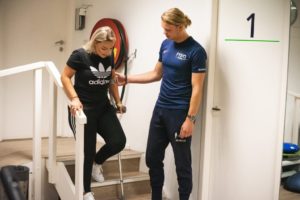What are hamstrings and what are their functions?
The hamstrings, also known as the hind thigh muscles, are an important muscle group at the back of the thigh. This group consists of three major muscles: the biceps femoris, semitendinosus, and semimembranosus. Located at the back of the thigh, the hamstrings extend from the ischium to just below the knee.
Functions of the hamstrings
Bending the Knee: One of the main functions of the hamstrings is to flex the knee. This is essential for activities such as walking, running and jumping.
Hip Stretching: The hamstrings contribute to hip extension, which is vital during movements such as rising from a sitting position or while walking.
Hull Support: The hamstrings also play a role in stabilizing the torso and helping to maintain good posture.
How do hamstring injuries occur?
Hamstring injuries often occur when these muscles become overloaded, stretched or torn. Sports activities that require sudden acceleration, deceleration or quick changes of direction, such as football, athletics and hockey, increase the risk of hamstring injuries.
Hamstring injuries, while often associated with athletes, can affect anyone involved in physical activities.
Symptoms of Hamstring Injuries:
The symptoms of a hamstring injury vary in severity and may include:
- Pain: Sharp or dull pain in the back of the thigh.
- Swelling: Sometimes swelling can occur in response to the injury.
- Limited Movement: Difficulty straightening or bending the leg.
- Cramps: Muscle cramps may occur as a result of the injury.
Types of hamstring injuries:
There are 2 types of hamstring injuries:
- Strains: Small tears in the muscle fibers, often accompanied by pain and swelling.
- Tears: Complete or partial breaks of the muscle fibers, which can cause more severe symptoms.
Treatments
In the event of a hamstring injury, it is essential to act quickly and effectively. Physiotherapy offers a holistic approach to recovery, focusing on:
- Pain relief: Through techniques such as massage and pain-relieving exercises.
- Recovery of Flexibility: With specific stretching exercises to improve the flexibility of the hamstrings.
- Muscle Strengthening: Customized exercise programs to build hamstring strength and prevent future injuries.
- Technique improvement: Guidance on correct posture and movement techniques to prevent recurrence of injuries.
- Rehabilitation plan: Drawing up a personalized rehabilitation plan, tailored to the specific needs of the patient.
Preventing hamstring injuries
Although injuries cannot always be prevented, there are certain steps that can be taken to reduce the risk:
- Proper warm-up: A thorough warm-up before physical activity helps prepare the muscles for exertion.
- Strength training: A well-balanced strength training program, with specific attention to the hamstrings, can provide protection.
- Flexibility exercises: Regular stretching exercises improve muscle flexibility and reduce the risk of injuries.
- Technique improvement: Learning the correct techniques during sports activities reduces the burden on the hamstrings.
Optimal recovery with the right physiotherapy
A hamstring injury can hinder your daily activities and sporting ambitions. Are you looking for effective treatments for hamstring injuries? With the expert guidance of our physiotherapists, patients can not only recover from injuries, but also work to prevent future problems.
Make one today appointment with Physiotherapy Iburg and discover how you can take the first step towards an injury-free recovery with the help of physiotherapy.











